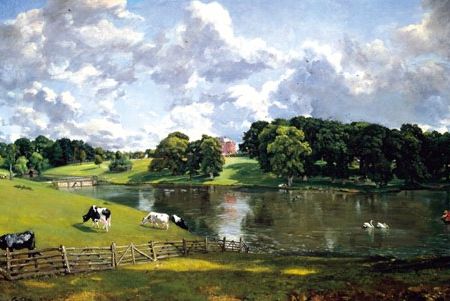Some of the best known landscapes painted by John Constable, one of the most important artist in the British world, have finally been reunited in a splendid exhibition at the National Gallery of Art in Washington. Beside the landscapes in the exhibition are being presented some of the beautiful full-size sketches, for the first time after Constable's death.
There are 55 landscapes, with a very impressive scale (mostly six feet large), oils and drawings, a pencil portrait and a series, in varied media, illustrating areas from "Constable Country", the region along Stour River in Suffolk. The main purpose of the exhibition, other than presenting Constable's magic style, is to find the answer to how the artist began to paint such large scale drawings.
For such big works, Constable needed a transitional phase, to make the shift from his small oil studies to the final paintings, and this phase is represented in the exhibition by the impressive sketches, very detailed. He wanted to paint landscapes that would be really impressive, because of their tehnique and their size, and succeded in a perfect way.

John Constable was born in 1776 in East Bergholt and was the son of Golding Constable, a wealthy and respected miller and businessman. From his childhood he was fasinated by the wattermills and the windmill that his father had, and spent a lot of time just watching them. John later went to school in Lavenham and then to the Grammar School in Dedham. At the age of 19 he was inspired to study art, after discovering several paintings and engravings at the local antiquarians. Mesmerized by their beauty, he started to paint and in 1799 he enrolled at the Royal Academy.
For the next ten years he would study and work their, and gained a little money painting copies of famous paitings and doing portraits. It was a good period, for he developped slowly a personal and mature style, characterised by the accuracy and attention to detail which will eventually bring his fame.
He was about 30 when he fell madly inlove with Maria Bicknell, who was the granddaughter of the Rector of East Bergholt. But the Rector couldn't approve such a relationship, for Constable was just a poor and struggling artist, so their love was confined to a few chance meetings and letters. It seemed that Constable's romantic dreams were destined to be shattered, when his fortune changed for the better. His father died, leaving him a small fortune, and eventually the couple married in 1816, settling in Hampstead. They had seven children, and it was the best time in Constable's career. He painted a lot, and slowly was gaining the fame he always wanted. But when Maria, who had been ill for a long time, died in 1828, it was also the end of the golden age in Constable's life.
He painted a great number of works, mainly landscapes, and today he is conseidered one of the most important landscape artists of all times.
October 2006

































